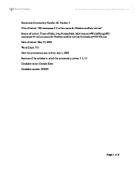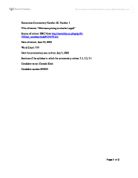The demise of the United State’s largest insurance company, American International Group has instigated shockwaves through Wall Street causing the government to intervene. The article uses facts and figures to show the affects of AIG’s plummeting stock on the world market. Due to the firm’s disastrous plunge in the market, the government faces the decision of bailing out AIG for a hefty sum of 85 billion dollars or allowing the firm to collapse. This monumental bailout from the government is possible because the United States’ has a mixed economy. A mixed economy is defined as an economic system where the fundamental economic question of ‘who, what for whom’ is solved by a mixture of government ownership/intervention/planning and the dynamics of market forces. The AIG intervention is a prime example of how the United States demonstrates this economic structure; the government is able to help failing institutions like AIG while allowing the free price system determine the demand and supply of other goods and services. There is a balance between individual ownership and government regulation. America’s financial authorities plan to rescue the large insurance company to prevent a crisis that can possibly create a domino effect throughout the United States’ economy. However, the government faces another dilemma with the expensive bailout. The opportunity cost involved in 85 billion tax dollars that could be spent elsewhere. Opportunity cost is defined as the relinquishing of the next best possible alternative in making a choice of ‘Alternative A’ over ‘Alternative B’. By investing 85 billion into rescuing AIG, the government is passing on the opportunity to spend the money on other purposes. The government could have used the funds to create and improve infrastructure like roads, communication and power management instead of expending it on fixing the mistakes of one big institution. America’s financial authorities can find the opportunity cost of this decision by obtaining the two highest ranked of all possible alternatives. In this particular situation, the next best alternative is the chance to develop and expand infrastructure programs. The opportunity cost can be illustrated on a production possibility frontier curve. A PPF curve is defined as a diagrammatical illustration of total attainable output based on the limits of available resources. As shown below, the choice to invest 85 billion dollars into AIG is located on the x-axis while the choice to use the money on infrastructure programs is located on the y-axis.







